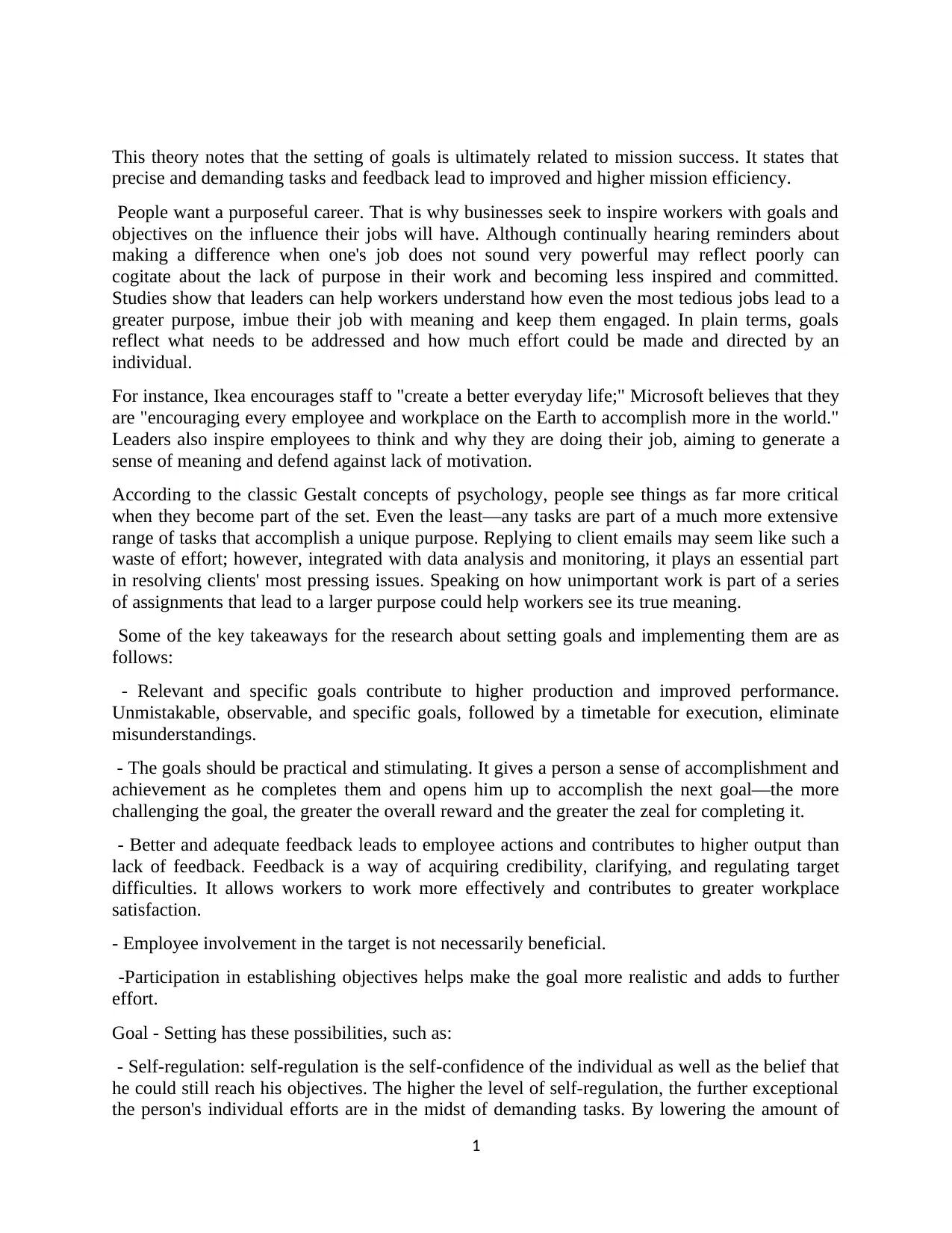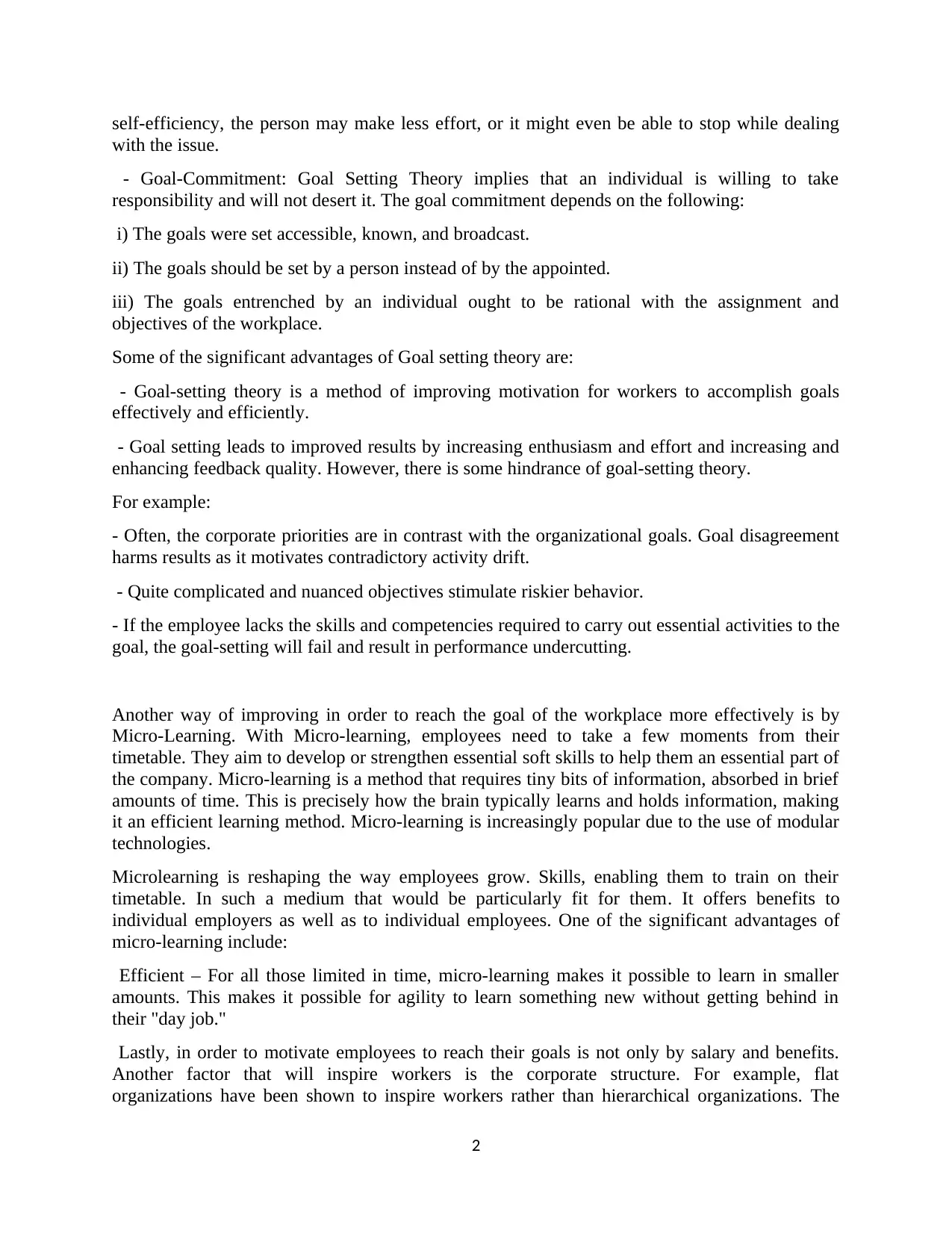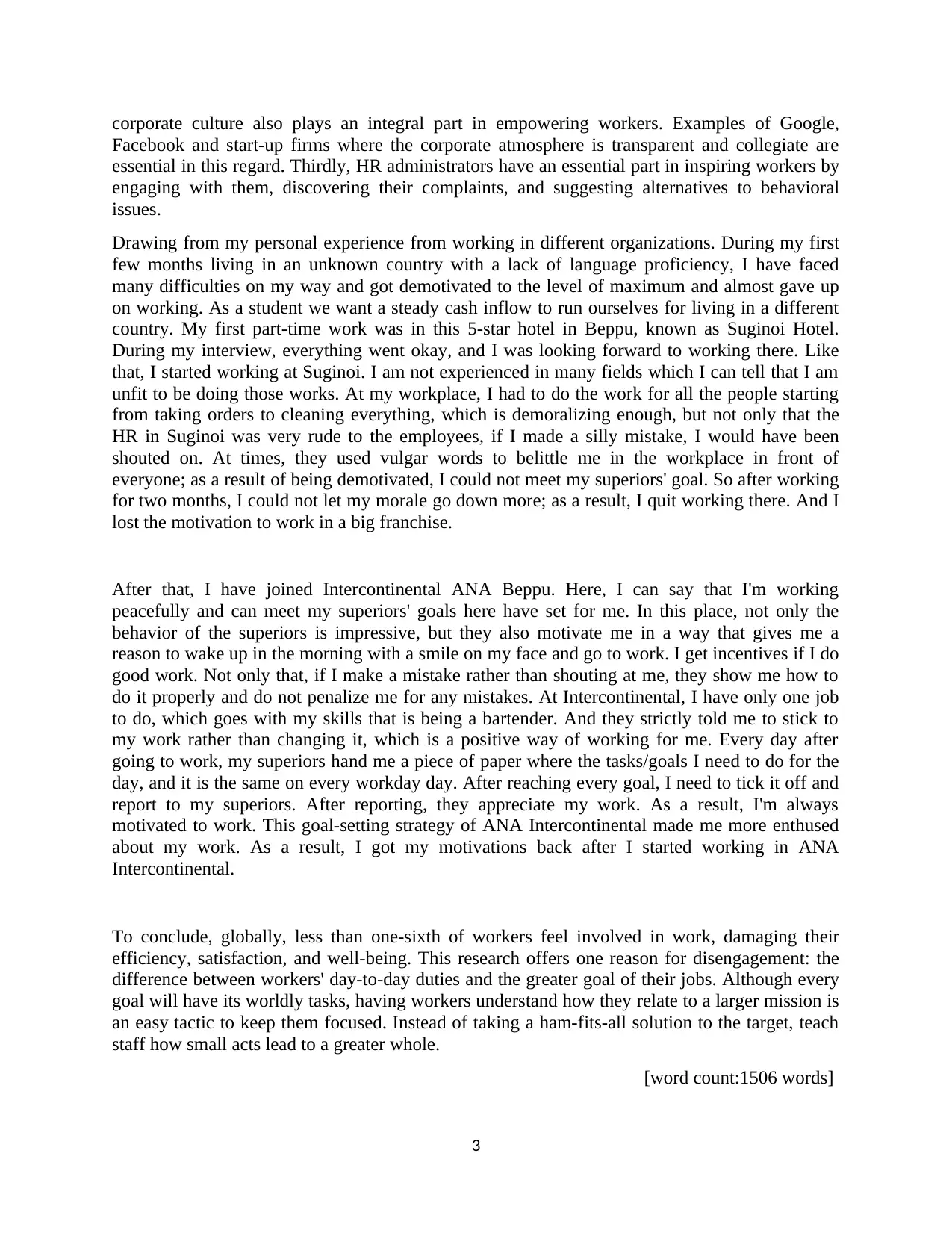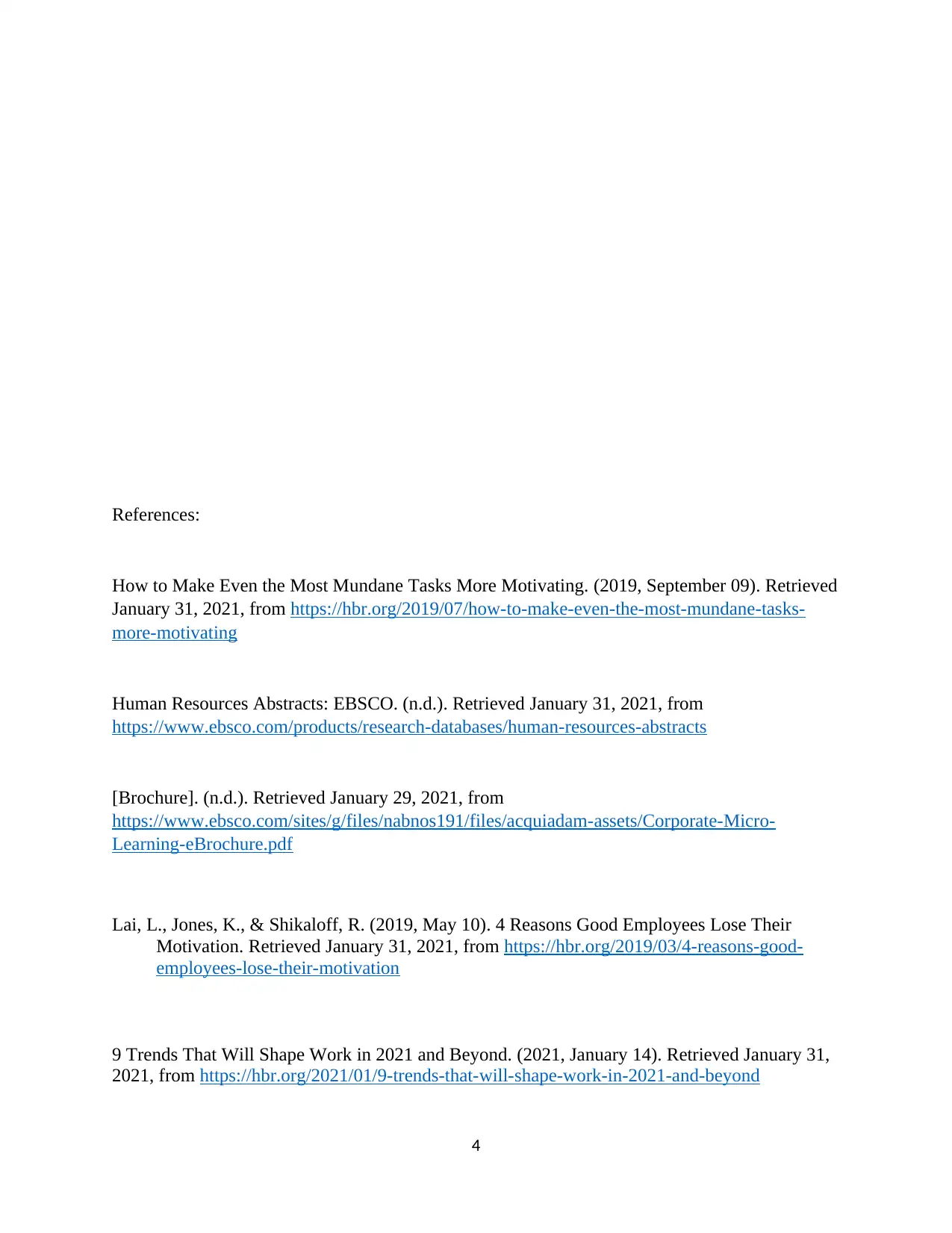Goal Setting, Micro-Learning, Corporate Culture, and Motivation Report
VerifiedAdded on 2021/07/28
|6
|1854
|125
Report
AI Summary
This report delves into the theory of goal setting and its profound impact on employee motivation and performance. It examines how setting specific, challenging goals, coupled with timely feedback, can significantly boost productivity and job satisfaction. The report also explores the role of micro-learning as an effective method for continuous skill development, enabling employees to learn in short, focused bursts. Furthermore, it highlights the influence of corporate culture, such as flat organizational structures and transparent communication, in fostering employee engagement. The report uses personal experiences to illustrate how leadership and a positive work environment, including incentives and constructive feedback, can significantly impact employee motivation and overall success. It concludes by emphasizing the importance of connecting daily tasks to a larger organizational purpose to keep employees engaged and driven.

JANUARY 31, 2021
Paraphrase This Document
Need a fresh take? Get an instant paraphrase of this document with our AI Paraphraser

This theory notes that the setting of goals is ultimately related to mission success. It states that
precise and demanding tasks and feedback lead to improved and higher mission efficiency.
People want a purposeful career. That is why businesses seek to inspire workers with goals and
objectives on the influence their jobs will have. Although continually hearing reminders about
making a difference when one's job does not sound very powerful may reflect poorly can
cogitate about the lack of purpose in their work and becoming less inspired and committed.
Studies show that leaders can help workers understand how even the most tedious jobs lead to a
greater purpose, imbue their job with meaning and keep them engaged. In plain terms, goals
reflect what needs to be addressed and how much effort could be made and directed by an
individual.
For instance, Ikea encourages staff to "create a better everyday life;" Microsoft believes that they
are "encouraging every employee and workplace on the Earth to accomplish more in the world."
Leaders also inspire employees to think and why they are doing their job, aiming to generate a
sense of meaning and defend against lack of motivation.
According to the classic Gestalt concepts of psychology, people see things as far more critical
when they become part of the set. Even the least—any tasks are part of a much more extensive
range of tasks that accomplish a unique purpose. Replying to client emails may seem like such a
waste of effort; however, integrated with data analysis and monitoring, it plays an essential part
in resolving clients' most pressing issues. Speaking on how unimportant work is part of a series
of assignments that lead to a larger purpose could help workers see its true meaning.
Some of the key takeaways for the research about setting goals and implementing them are as
follows:
- Relevant and specific goals contribute to higher production and improved performance.
Unmistakable, observable, and specific goals, followed by a timetable for execution, eliminate
misunderstandings.
- The goals should be practical and stimulating. It gives a person a sense of accomplishment and
achievement as he completes them and opens him up to accomplish the next goal—the more
challenging the goal, the greater the overall reward and the greater the zeal for completing it.
- Better and adequate feedback leads to employee actions and contributes to higher output than
lack of feedback. Feedback is a way of acquiring credibility, clarifying, and regulating target
difficulties. It allows workers to work more effectively and contributes to greater workplace
satisfaction.
- Employee involvement in the target is not necessarily beneficial.
-Participation in establishing objectives helps make the goal more realistic and adds to further
effort.
Goal - Setting has these possibilities, such as:
- Self-regulation: self-regulation is the self-confidence of the individual as well as the belief that
he could still reach his objectives. The higher the level of self-regulation, the further exceptional
the person's individual efforts are in the midst of demanding tasks. By lowering the amount of
1
precise and demanding tasks and feedback lead to improved and higher mission efficiency.
People want a purposeful career. That is why businesses seek to inspire workers with goals and
objectives on the influence their jobs will have. Although continually hearing reminders about
making a difference when one's job does not sound very powerful may reflect poorly can
cogitate about the lack of purpose in their work and becoming less inspired and committed.
Studies show that leaders can help workers understand how even the most tedious jobs lead to a
greater purpose, imbue their job with meaning and keep them engaged. In plain terms, goals
reflect what needs to be addressed and how much effort could be made and directed by an
individual.
For instance, Ikea encourages staff to "create a better everyday life;" Microsoft believes that they
are "encouraging every employee and workplace on the Earth to accomplish more in the world."
Leaders also inspire employees to think and why they are doing their job, aiming to generate a
sense of meaning and defend against lack of motivation.
According to the classic Gestalt concepts of psychology, people see things as far more critical
when they become part of the set. Even the least—any tasks are part of a much more extensive
range of tasks that accomplish a unique purpose. Replying to client emails may seem like such a
waste of effort; however, integrated with data analysis and monitoring, it plays an essential part
in resolving clients' most pressing issues. Speaking on how unimportant work is part of a series
of assignments that lead to a larger purpose could help workers see its true meaning.
Some of the key takeaways for the research about setting goals and implementing them are as
follows:
- Relevant and specific goals contribute to higher production and improved performance.
Unmistakable, observable, and specific goals, followed by a timetable for execution, eliminate
misunderstandings.
- The goals should be practical and stimulating. It gives a person a sense of accomplishment and
achievement as he completes them and opens him up to accomplish the next goal—the more
challenging the goal, the greater the overall reward and the greater the zeal for completing it.
- Better and adequate feedback leads to employee actions and contributes to higher output than
lack of feedback. Feedback is a way of acquiring credibility, clarifying, and regulating target
difficulties. It allows workers to work more effectively and contributes to greater workplace
satisfaction.
- Employee involvement in the target is not necessarily beneficial.
-Participation in establishing objectives helps make the goal more realistic and adds to further
effort.
Goal - Setting has these possibilities, such as:
- Self-regulation: self-regulation is the self-confidence of the individual as well as the belief that
he could still reach his objectives. The higher the level of self-regulation, the further exceptional
the person's individual efforts are in the midst of demanding tasks. By lowering the amount of
1

self-efficiency, the person may make less effort, or it might even be able to stop while dealing
with the issue.
- Goal-Commitment: Goal Setting Theory implies that an individual is willing to take
responsibility and will not desert it. The goal commitment depends on the following:
i) The goals were set accessible, known, and broadcast.
ii) The goals should be set by a person instead of by the appointed.
iii) The goals entrenched by an individual ought to be rational with the assignment and
objectives of the workplace.
Some of the significant advantages of Goal setting theory are:
- Goal-setting theory is a method of improving motivation for workers to accomplish goals
effectively and efficiently.
- Goal setting leads to improved results by increasing enthusiasm and effort and increasing and
enhancing feedback quality. However, there is some hindrance of goal-setting theory.
For example:
- Often, the corporate priorities are in contrast with the organizational goals. Goal disagreement
harms results as it motivates contradictory activity drift.
- Quite complicated and nuanced objectives stimulate riskier behavior.
- If the employee lacks the skills and competencies required to carry out essential activities to the
goal, the goal-setting will fail and result in performance undercutting.
Another way of improving in order to reach the goal of the workplace more effectively is by
Micro-Learning. With Micro-learning, employees need to take a few moments from their
timetable. They aim to develop or strengthen essential soft skills to help them an essential part of
the company. Micro-learning is a method that requires tiny bits of information, absorbed in brief
amounts of time. This is precisely how the brain typically learns and holds information, making
it an efficient learning method. Micro-learning is increasingly popular due to the use of modular
technologies.
Microlearning is reshaping the way employees grow. Skills, enabling them to train on their
timetable. In such a medium that would be particularly fit for them. It offers benefits to
individual employers as well as to individual employees. One of the significant advantages of
micro-learning include:
Efficient – For all those limited in time, micro-learning makes it possible to learn in smaller
amounts. This makes it possible for agility to learn something new without getting behind in
their "day job."
Lastly, in order to motivate employees to reach their goals is not only by salary and benefits.
Another factor that will inspire workers is the corporate structure. For example, flat
organizations have been shown to inspire workers rather than hierarchical organizations. The
2
with the issue.
- Goal-Commitment: Goal Setting Theory implies that an individual is willing to take
responsibility and will not desert it. The goal commitment depends on the following:
i) The goals were set accessible, known, and broadcast.
ii) The goals should be set by a person instead of by the appointed.
iii) The goals entrenched by an individual ought to be rational with the assignment and
objectives of the workplace.
Some of the significant advantages of Goal setting theory are:
- Goal-setting theory is a method of improving motivation for workers to accomplish goals
effectively and efficiently.
- Goal setting leads to improved results by increasing enthusiasm and effort and increasing and
enhancing feedback quality. However, there is some hindrance of goal-setting theory.
For example:
- Often, the corporate priorities are in contrast with the organizational goals. Goal disagreement
harms results as it motivates contradictory activity drift.
- Quite complicated and nuanced objectives stimulate riskier behavior.
- If the employee lacks the skills and competencies required to carry out essential activities to the
goal, the goal-setting will fail and result in performance undercutting.
Another way of improving in order to reach the goal of the workplace more effectively is by
Micro-Learning. With Micro-learning, employees need to take a few moments from their
timetable. They aim to develop or strengthen essential soft skills to help them an essential part of
the company. Micro-learning is a method that requires tiny bits of information, absorbed in brief
amounts of time. This is precisely how the brain typically learns and holds information, making
it an efficient learning method. Micro-learning is increasingly popular due to the use of modular
technologies.
Microlearning is reshaping the way employees grow. Skills, enabling them to train on their
timetable. In such a medium that would be particularly fit for them. It offers benefits to
individual employers as well as to individual employees. One of the significant advantages of
micro-learning include:
Efficient – For all those limited in time, micro-learning makes it possible to learn in smaller
amounts. This makes it possible for agility to learn something new without getting behind in
their "day job."
Lastly, in order to motivate employees to reach their goals is not only by salary and benefits.
Another factor that will inspire workers is the corporate structure. For example, flat
organizations have been shown to inspire workers rather than hierarchical organizations. The
2
⊘ This is a preview!⊘
Do you want full access?
Subscribe today to unlock all pages.

Trusted by 1+ million students worldwide

corporate culture also plays an integral part in empowering workers. Examples of Google,
Facebook and start-up firms where the corporate atmosphere is transparent and collegiate are
essential in this regard. Thirdly, HR administrators have an essential part in inspiring workers by
engaging with them, discovering their complaints, and suggesting alternatives to behavioral
issues.
Drawing from my personal experience from working in different organizations. During my first
few months living in an unknown country with a lack of language proficiency, I have faced
many difficulties on my way and got demotivated to the level of maximum and almost gave up
on working. As a student we want a steady cash inflow to run ourselves for living in a different
country. My first part-time work was in this 5-star hotel in Beppu, known as Suginoi Hotel.
During my interview, everything went okay, and I was looking forward to working there. Like
that, I started working at Suginoi. I am not experienced in many fields which I can tell that I am
unfit to be doing those works. At my workplace, I had to do the work for all the people starting
from taking orders to cleaning everything, which is demoralizing enough, but not only that the
HR in Suginoi was very rude to the employees, if I made a silly mistake, I would have been
shouted on. At times, they used vulgar words to belittle me in the workplace in front of
everyone; as a result of being demotivated, I could not meet my superiors' goal. So after working
for two months, I could not let my morale go down more; as a result, I quit working there. And I
lost the motivation to work in a big franchise.
After that, I have joined Intercontinental ANA Beppu. Here, I can say that I'm working
peacefully and can meet my superiors' goals here have set for me. In this place, not only the
behavior of the superiors is impressive, but they also motivate me in a way that gives me a
reason to wake up in the morning with a smile on my face and go to work. I get incentives if I do
good work. Not only that, if I make a mistake rather than shouting at me, they show me how to
do it properly and do not penalize me for any mistakes. At Intercontinental, I have only one job
to do, which goes with my skills that is being a bartender. And they strictly told me to stick to
my work rather than changing it, which is a positive way of working for me. Every day after
going to work, my superiors hand me a piece of paper where the tasks/goals I need to do for the
day, and it is the same on every workday day. After reaching every goal, I need to tick it off and
report to my superiors. After reporting, they appreciate my work. As a result, I'm always
motivated to work. This goal-setting strategy of ANA Intercontinental made me more enthused
about my work. As a result, I got my motivations back after I started working in ANA
Intercontinental.
To conclude, globally, less than one-sixth of workers feel involved in work, damaging their
efficiency, satisfaction, and well-being. This research offers one reason for disengagement: the
difference between workers' day-to-day duties and the greater goal of their jobs. Although every
goal will have its worldly tasks, having workers understand how they relate to a larger mission is
an easy tactic to keep them focused. Instead of taking a ham-fits-all solution to the target, teach
staff how small acts lead to a greater whole.
[word count:1506 words]
3
Facebook and start-up firms where the corporate atmosphere is transparent and collegiate are
essential in this regard. Thirdly, HR administrators have an essential part in inspiring workers by
engaging with them, discovering their complaints, and suggesting alternatives to behavioral
issues.
Drawing from my personal experience from working in different organizations. During my first
few months living in an unknown country with a lack of language proficiency, I have faced
many difficulties on my way and got demotivated to the level of maximum and almost gave up
on working. As a student we want a steady cash inflow to run ourselves for living in a different
country. My first part-time work was in this 5-star hotel in Beppu, known as Suginoi Hotel.
During my interview, everything went okay, and I was looking forward to working there. Like
that, I started working at Suginoi. I am not experienced in many fields which I can tell that I am
unfit to be doing those works. At my workplace, I had to do the work for all the people starting
from taking orders to cleaning everything, which is demoralizing enough, but not only that the
HR in Suginoi was very rude to the employees, if I made a silly mistake, I would have been
shouted on. At times, they used vulgar words to belittle me in the workplace in front of
everyone; as a result of being demotivated, I could not meet my superiors' goal. So after working
for two months, I could not let my morale go down more; as a result, I quit working there. And I
lost the motivation to work in a big franchise.
After that, I have joined Intercontinental ANA Beppu. Here, I can say that I'm working
peacefully and can meet my superiors' goals here have set for me. In this place, not only the
behavior of the superiors is impressive, but they also motivate me in a way that gives me a
reason to wake up in the morning with a smile on my face and go to work. I get incentives if I do
good work. Not only that, if I make a mistake rather than shouting at me, they show me how to
do it properly and do not penalize me for any mistakes. At Intercontinental, I have only one job
to do, which goes with my skills that is being a bartender. And they strictly told me to stick to
my work rather than changing it, which is a positive way of working for me. Every day after
going to work, my superiors hand me a piece of paper where the tasks/goals I need to do for the
day, and it is the same on every workday day. After reaching every goal, I need to tick it off and
report to my superiors. After reporting, they appreciate my work. As a result, I'm always
motivated to work. This goal-setting strategy of ANA Intercontinental made me more enthused
about my work. As a result, I got my motivations back after I started working in ANA
Intercontinental.
To conclude, globally, less than one-sixth of workers feel involved in work, damaging their
efficiency, satisfaction, and well-being. This research offers one reason for disengagement: the
difference between workers' day-to-day duties and the greater goal of their jobs. Although every
goal will have its worldly tasks, having workers understand how they relate to a larger mission is
an easy tactic to keep them focused. Instead of taking a ham-fits-all solution to the target, teach
staff how small acts lead to a greater whole.
[word count:1506 words]
3
Paraphrase This Document
Need a fresh take? Get an instant paraphrase of this document with our AI Paraphraser

References:
How to Make Even the Most Mundane Tasks More Motivating. (2019, September 09). Retrieved
January 31, 2021, from https://hbr.org/2019/07/how-to-make-even-the-most-mundane-tasks-
more-motivating
Human Resources Abstracts: EBSCO. (n.d.). Retrieved January 31, 2021, from
https://www.ebsco.com/products/research-databases/human-resources-abstracts
[Brochure]. (n.d.). Retrieved January 29, 2021, from
https://www.ebsco.com/sites/g/files/nabnos191/files/acquiadam-assets/Corporate-Micro-
Learning-eBrochure.pdf
Lai, L., Jones, K., & Shikaloff, R. (2019, May 10). 4 Reasons Good Employees Lose Their
Motivation. Retrieved January 31, 2021, from https://hbr.org/2019/03/4-reasons-good-
employees-lose-their-motivation
9 Trends That Will Shape Work in 2021 and Beyond. (2021, January 14). Retrieved January 31,
2021, from https://hbr.org/2021/01/9-trends-that-will-shape-work-in-2021-and-beyond
4
How to Make Even the Most Mundane Tasks More Motivating. (2019, September 09). Retrieved
January 31, 2021, from https://hbr.org/2019/07/how-to-make-even-the-most-mundane-tasks-
more-motivating
Human Resources Abstracts: EBSCO. (n.d.). Retrieved January 31, 2021, from
https://www.ebsco.com/products/research-databases/human-resources-abstracts
[Brochure]. (n.d.). Retrieved January 29, 2021, from
https://www.ebsco.com/sites/g/files/nabnos191/files/acquiadam-assets/Corporate-Micro-
Learning-eBrochure.pdf
Lai, L., Jones, K., & Shikaloff, R. (2019, May 10). 4 Reasons Good Employees Lose Their
Motivation. Retrieved January 31, 2021, from https://hbr.org/2019/03/4-reasons-good-
employees-lose-their-motivation
9 Trends That Will Shape Work in 2021 and Beyond. (2021, January 14). Retrieved January 31,
2021, from https://hbr.org/2021/01/9-trends-that-will-shape-work-in-2021-and-beyond
4

5
⊘ This is a preview!⊘
Do you want full access?
Subscribe today to unlock all pages.

Trusted by 1+ million students worldwide
1 out of 6
Related Documents
Your All-in-One AI-Powered Toolkit for Academic Success.
+13062052269
info@desklib.com
Available 24*7 on WhatsApp / Email
![[object Object]](/_next/static/media/star-bottom.7253800d.svg)
Unlock your academic potential
Copyright © 2020–2025 A2Z Services. All Rights Reserved. Developed and managed by ZUCOL.



